Clay sculpting calms your anxious mind by engaging multiple senses and redirecting your focus to the present moment. As you knead and shape the clay, you'll experience a deeply satisfying tactile sensation that grounds you in the here and now. The repetitive, rhythmic movements can induce a meditative state, helping to break anxious thought patterns. Clay's malleable nature allows you to express emotions without words, providing a safe outlet for complex feelings. The process of transforming formless clay into structured shapes mirrors the organization of your thoughts, fostering a sense of control. Discover how this versatile art form can become your go-to stress relief tool.
The Tactile Nature of Clay

Clay's texture-rich surface engages your sense of touch, providing a deeply satisfying tactile experience. As you knead, mold, and shape the clay, you'll feel its coolness and malleability between your fingers. This hands-on interaction activates your sensory receptors, creating a powerful connection between your mind and the material.
The act of manipulating clay stimulates your proprioception – your body's awareness of its position in space. As you work, you'll become acutely aware of the pressure and movements of your hands, grounding you in the present moment. This heightened physical awareness can help shift your focus away from anxious thoughts.
Clay's responsiveness to your touch offers immediate feedback, allowing you to see and feel the results of your actions in real-time. This instant gratification can boost your sense of control and accomplishment. The clay's forgiving nature also encourages experimentation and reduces fear of mistakes, fostering a sense of freedom and creativity.
The tactile nature of clay engages multiple senses simultaneously, creating an immersive experience that can effectively distract your mind from anxiety-inducing thoughts and promote a state of flow and relaxation.
Engaging the Senses
Clay sculpting engages multiple senses, offering a powerful way to redirect your anxious mind.
As you knead and shape the clay, you'll feel its texture and temperature, grounding you in the present moment.
This mindful sensory experience can provide tactile stress relief, helping you focus on the physical sensations rather than anxious thoughts.
Tactile Stress Relief
As you sink your fingers into the cool, pliable clay, your senses immediately engage in a tactile experience that can provide powerful stress relief. The physical act of manipulating clay offers a unique form of relaxation that can help calm your anxious mind.
Clay sculpting provides tactile stress relief through several mechanisms:
- Repetitive motions: Kneading, rolling, and shaping clay involve repetitive movements that can be soothing and meditative.
- Sensory stimulation: The texture and temperature of the clay provide sensory input that can help ground you in the present moment.
- Physical release: Squeezing and molding clay allows you to channel tension and negative emotions into a productive activity.
- Focus shift: Concentrating on the clay's texture and your creation redirects your attention from anxious thoughts.
As you work with the clay, you'll notice your muscles relaxing and your breathing becoming more steady.
The tactile nature of clay sculpting engages your body and mind, creating a natural stress-relief outlet. By focusing on the physical sensations and the creative process, you're giving your anxious thoughts less room to dominate your mental space.
Mindful Sensory Experience
Engaging your senses fully during clay sculpting can transform the activity into a powerful mindfulness practice. As you work with the clay, focus on the present moment and the sensations you're experiencing.
Feel the cool, damp texture of the clay against your skin, noticing how it warms and softens as you manipulate it. Observe the subtle changes in color and sheen as you mold the material.
Listen to the quiet sounds of the clay as you work it—the soft squishing and gentle tapping. Inhale deeply and notice the earthy scent of the clay, which can help ground you in the present.
Watch how the light plays on the surface of your creation, highlighting contours and shadows.
Mindful Focus on Creation

As you shape the clay, you're naturally drawn into a state of mindful focus.
Your hands become one with the material, grounding you in the present moment through tactile engagement.
This artistic expression allows you to channel your thoughts and emotions into a tangible creation, shifting your attention away from anxious thoughts.
Grounding Through Tactile Engagement
Clay sculpting brings you back to earth through its intensely tactile nature. As you work with the clay, your hands become intimately connected with the material, engaging your sense of touch in a way that few other activities can match. This physical connection helps anchor you in the present moment, pulling your mind away from anxious thoughts and worries.
The grounding effect of clay sculpting comes from several key aspects:
- Temperature: Clay's cool touch against your skin provides immediate sensory feedback.
- Texture: The smooth, pliable consistency of clay offers a soothing tactile experience.
- Resistance: Kneading and shaping clay requires physical effort, engaging your muscles and focusing your attention.
- Transformation: Witnessing the clay change under your hands gives you a sense of control and accomplishment.
As you mold and shape the clay, you're not just creating art – you're actively participating in a form of tactile meditation. Your fingers explore every curve and crevice, keeping your mind tethered to the physical world.
This hands-on engagement helps quiet the internal chatter of anxiety, allowing you to find moments of peace and clarity through the simple act of touching and manipulating clay.
Present-Moment Artistic Expression
Immerse yourself in the present moment through clay sculpting's artistic expression. As you mold and shape the clay, you're forced to focus on the task at hand, leaving little room for anxious thoughts about the past or future. This mindful creation process engages your senses and requires your full attention, effectively anchoring you to the now.
Clay's malleable nature allows for spontaneous creativity, encouraging you to express your emotions without judgment. You'll find that your hands intuitively respond to your inner state, translating feelings into tangible forms. This non-verbal expression can be particularly therapeutic when words fail to capture your anxiety.
As you work, you'll notice how your breath naturally syncs with your movements, further enhancing your present-moment awareness. The rhythmic nature of kneading, rolling, and sculpting clay can induce a meditative state, calming your nervous system.
Moreover, the act of creating something unique provides a sense of accomplishment and control, which can be empowering when anxiety makes you feel helpless. By channeling your energy into artistic expression, you're actively transforming your anxiety into a positive, creative outlet.
Grounding Through Physical Contact
The tactile nature of clay sculpting provides a powerful grounding experience. As you work with the clay, you're physically connected to the present moment, which can help reduce anxiety and racing thoughts. Your hands become fully engaged, creating a direct link between your mind and the material.
This physical contact activates your senses and redirects your focus from internal worries to the external world.
Clay's malleable properties offer unique benefits for grounding:
- Temperature sensitivity: You'll feel the clay warm up as you work, heightening your awareness of your body's interaction with the material.
- Texture variations: Smooth, rough, or grainy surfaces provide diverse sensory input, keeping you engaged.
- Resistance and yield: The push and pull of molding clay offers a satisfying physical outlet for tension.
- Immediate feedback: Every touch leaves an imprint, giving you instant visual and tactile responses to your actions.
Expressing Emotions Without Words
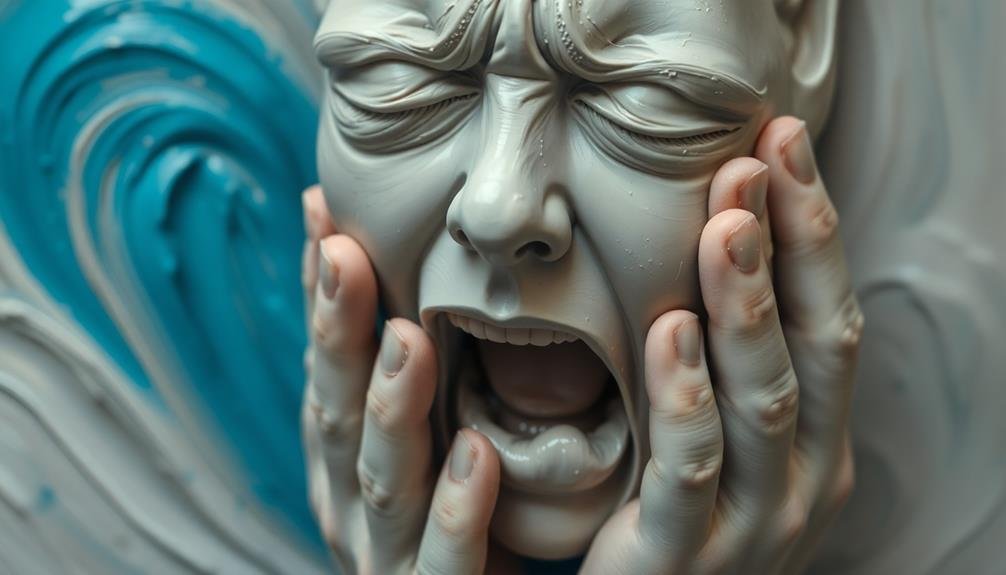
Often, anxiety stems from emotions that are difficult to verbalize. Clay sculpting offers you a powerful way to express these complex feelings without relying on words. As you mold and shape the clay, you're giving form to your inner turmoil, fears, and hopes.
You'll find that your hands intuitively create shapes and textures that reflect your emotional state. A tightly wound ball might represent tension, while smooth, flowing forms could signify a desire for calm. The act of physically manipulating the clay allows you to externalize your emotions, making them easier to process and understand.
This nonverbal expression can be particularly helpful when you're overwhelmed or struggling to articulate your feelings. You're not constrained by language limitations or the fear of being misunderstood. Instead, you're free to explore and represent your emotions in a tangible, three-dimensional form.
As you work with the clay, you might discover insights about your anxiety that weren't apparent before. The finished sculpture serves as a visual representation of your emotional journey, allowing you to gain perspective and distance from your anxious thoughts.
Breaking Repetitive Thought Patterns
When you're caught in a spiral of anxious thoughts, clay sculpting can disrupt these mental loops.
You'll shift your focus to the tactile sensations of molding and shaping the clay, engaging your senses in a new way.
This physical activity redirects your attention, helping to break the cycle of repetitive thinking and offering a fresh perspective.
Disrupting Mental Loops
Repetitive thoughts can trap you in a mental maze, but clay sculpting offers a powerful escape route. As you focus on molding and shaping the clay, you're forced to redirect your attention away from anxious ruminations. This tactile engagement interrupts the cycle of negative thoughts, giving your mind a much-needed reprieve.
Clay sculpting disrupts mental loops in several ways:
- Sensory stimulation: The texture and temperature of the clay engage your senses, grounding you in the present moment.
- Cognitive redirection: Planning and executing your sculpture requires active problem-solving, leaving less mental space for anxiety.
- Physical movement: The act of manipulating clay involves fine motor skills, which can help release tension and shift your focus.
- Creative expression: Translating your emotions into a tangible form provides an outlet for pent-up feelings.
Focusing on Tactile Sensations
Clay's tactile nature provides a powerful anchor for your senses, drawing you away from anxious thoughts. As you work with clay, you'll experience a range of textures and sensations that demand your attention. Your fingers will sink into soft, pliable material, feeling its coolness and moisture. You'll knead and stretch the clay, noticing how it responds to pressure and movement.
This focus on tactile sensations helps break the cycle of repetitive, anxious thoughts. Your mind becomes absorbed in the physical experience, leaving less room for worry. You'll find yourself noticing:
| Sensation | Experience |
|---|---|
| Texture | Smooth, gritty, or rough |
| Temperature | Cool to warm as you work |
| Moisture | Damp or dry depending on clay type |
| Plasticity | Pliable or firm resistance |
| Weight | Light or heavy in your hands |
Embracing Imperfections in Art

Embracing imperfections in art can open up a world of creative freedom and self-expression. When you're sculpting with clay, you'll quickly realize that not everything will turn out exactly as you envision. This is where the magic happens. Instead of striving for flawlessness, allow yourself to explore the beauty in asymmetry, rough textures, and unexpected shapes.
By accepting imperfections, you'll:
- Reduce anxiety about achieving a specific outcome
- Discover new artistic techniques and styles
- Develop a more authentic and personal artistic voice
- Learn to apply this mindset to other areas of your life
As you work with the clay, pay attention to how it feels to let go of control. Notice the relief that comes with accepting things as they are, rather than how you think they should be.
This practice can have a profound impact on your overall anxiety levels. You'll find that embracing imperfections in your art translates to greater self-acceptance and reduced stress in your daily life.
Clay as a Stress Ball
Beyond its artistic applications, clay can serve as an excellent alternative to traditional stress balls. When you're feeling anxious or overwhelmed, simply kneading and squeezing a lump of clay can provide immediate relief. The malleable nature of clay allows you to channel your nervous energy into physical manipulation, helping to redirect your focus and calm your mind.
Unlike conventional stress balls, clay offers a more versatile and engaging experience. You can roll it, flatten it, punch it, or even tear it apart, providing a range of tactile sensations that cater to different stress-relief needs. The act of repeatedly reshaping the clay can be meditative, allowing you to enter a flow state that reduces anxiety and promotes relaxation.
Clay's temperature and texture also play a role in its stress-relieving properties. As you work with it, the clay warms up, creating a soothing sensation in your hands. The smooth, cool feel of fresh clay can be grounding, helping to anchor you in the present moment and away from anxious thoughts.
Keep a small ball of clay at your desk or in your pocket for quick stress relief throughout the day.
Rhythmic Movements in Sculpting

The repetitive, rhythmic movements involved in clay sculpting can greatly enhance its anxiety-reducing effects. As you work with clay, you'll find yourself engaging in a series of soothing, methodical actions that can help calm your mind and reduce stress.
These movements often mimic the rhythm of slow, deep breathing, which is known to activate the body's relaxation response.
When you're sculpting, you'll typically engage in four main types of rhythmic movements:
- Kneading: Repeatedly pressing and folding the clay to prepare it for shaping
- Rolling: Creating even surfaces or cylindrical forms by moving your hands back and forth
- Pinching: Using your thumb and fingers to form delicate shapes or add details
- Smoothing: Gently running your fingers over the clay's surface to refine its texture
These repetitive actions can help you enter a meditative state, allowing your mind to focus on the present moment and let go of anxious thoughts.
As you become absorbed in the rhythmic movements of sculpting, you'll likely find your breathing slows, your muscles relax, and your overall sense of well-being improves.
Creating Order From Chaos
Clay sculpting offers a unique opportunity to create order from chaos. As you mold and shape the formless lump of clay, you're actively transforming disorder into structure. This process mirrors the way you can reshape your anxious thoughts into more manageable, organized patterns.
When you begin with a shapeless mass of clay, you're faced with endless possibilities. You'll decide what form it'll take, giving you control over the creative process. This sense of control can be particularly soothing when anxiety makes you feel powerless in other areas of your life.
Consider the following stages of creating order through clay sculpting:
| Stage | Mental Benefit |
|---|---|
| Planning | Focuses scattered thoughts |
| Shaping | Builds confidence in decision-making |
| Refining | Enhances attention to detail |
| Completing | Provides sense of accomplishment |
As you progress through these stages, you'll notice your mind becoming more focused and less cluttered. The act of imposing structure on the clay can help you visualize doing the same with your anxious thoughts, making them feel more manageable and less overwhelming.
Frequently Asked Questions
Can Clay Sculpting Help With Specific Anxiety Disorders Like PTSD or OCD?
Yes, clay sculpting can help with specific anxiety disorders like PTSD and OCD. It's a form of art therapy that can reduce stress, improve focus, and provide a tactile outlet for your emotions. You'll find it calming and therapeutic.
Are There Any Potential Negative Effects of Using Clay for Anxiety Relief?
While clay sculpting can be beneficial, you might experience some drawbacks. You could develop skin irritation from certain clays, or become frustrated if your creations don't meet expectations. It's also possible to become overly reliant on this coping mechanism.
How Long Should a Clay Sculpting Session Last for Optimal Anxiety Reduction?
You'll want to aim for 20-30 minutes of clay sculpting for ideal anxiety reduction. However, don't feel constrained by time. Listen to your body and stop when you're feeling calmer. It's about quality, not quantity.
Can Clay Sculpting Be Combined With Other Anxiety Management Techniques for Better Results?
Yes, you can combine clay sculpting with other anxiety management techniques for enhanced results. Try incorporating deep breathing exercises, mindfulness meditation, or calming music while you sculpt. This multi-faceted approach can amplify your anxiety reduction efforts.
Is There a Difference Between Using Air-Dry Clay Versus Kiln-Fired Clay for Anxiety?
You'll find both air-dry and kiln-fired clay can help with anxiety. Air-dry's easier to use at home, while kiln-fired offers a more involved process. Your preference depends on your needs and the experience you're seeking.
In Summary
You've discovered a powerful tool for calming your anxious mind through clay sculpting. As you mold and shape the clay, you're not just creating art—you're crafting peace within yourself. Embrace this tactile, sensory experience. Let your hands guide you, express your emotions, and find solace in the imperfections. Remember, it's not about perfection; it's about the journey. So, pick up that clay and let your worries melt away with each gentle touch.

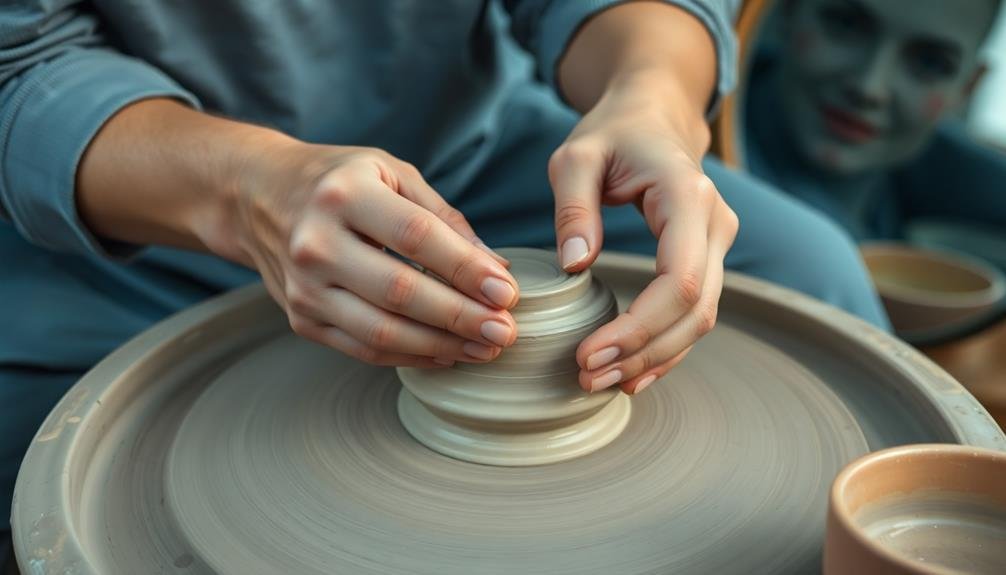
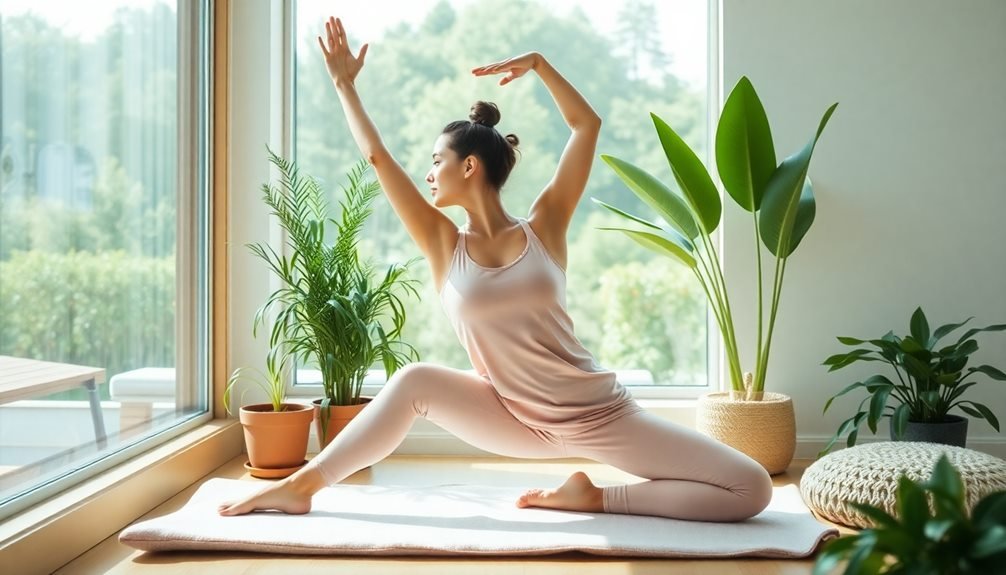
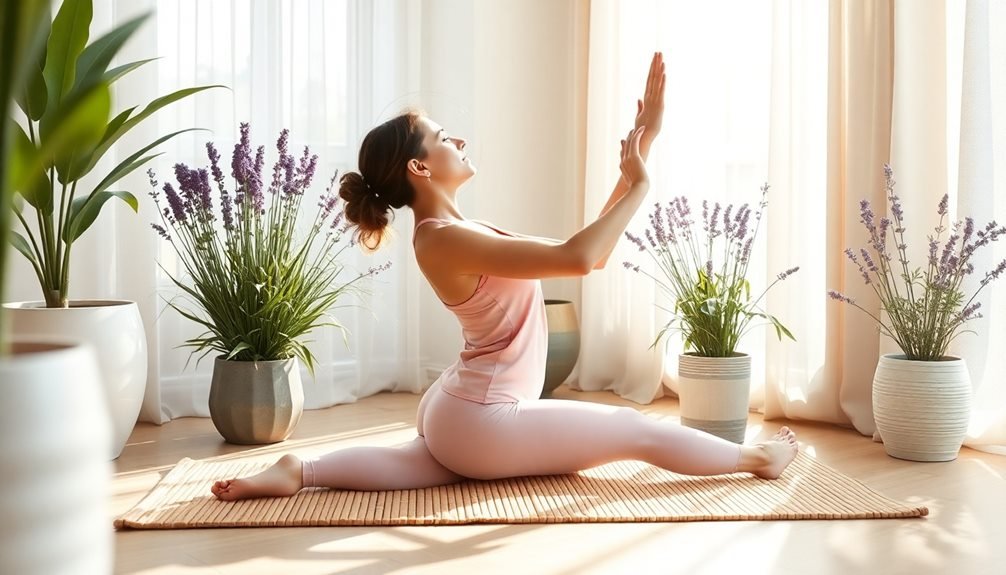
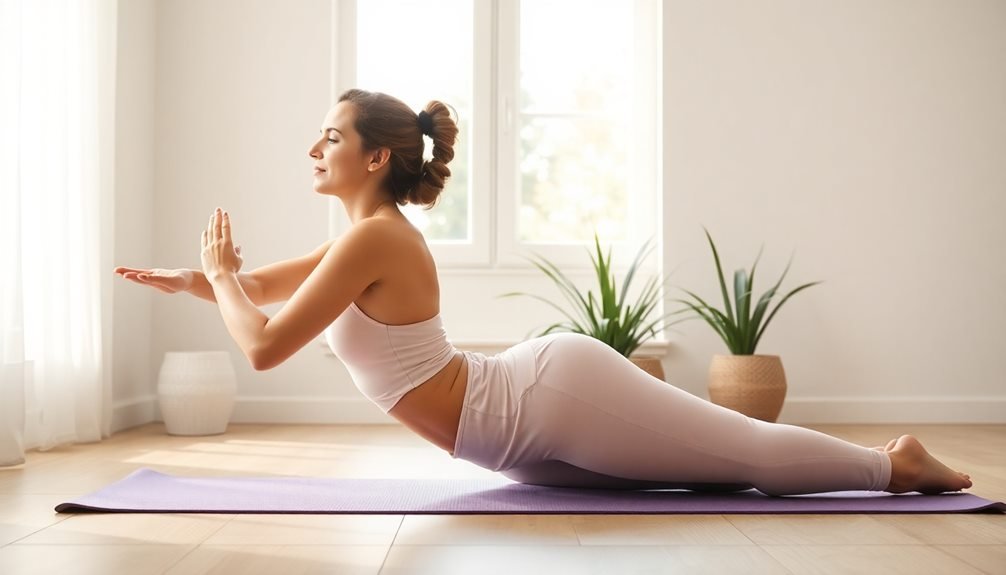
Leave a Reply